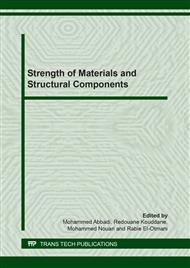[1]
Jean-Marie Michel, Contribution à l'histoire industrielle des polymères en France, Société Chimique de France (Avril 2012).
Google Scholar
[2]
Norme EN ISO 15877, Système de canalisation en plastique pour les installations d'eau chaude et d'eau froide –polychlorure de vinyle chlore (PVC-C).
Google Scholar
[3]
Dubuc.J, Thang.B.O, Bazergui.A, and Biron.A. Unified theory of cumulative damage in metal fatigue. WRC Bulletin, 1971, 1-20.
Google Scholar
[4]
Bathias.C, André Pineau. Fatigue of materials and structure: application to design. John Wiley and Sons, (2013).
Google Scholar
[5]
Gatts.R.R, Application of a cumulative damage concept to fatigue, Journal f Basic Engineering, 1961, 83(4), 529-534.
DOI: 10.1115/1.3662256
Google Scholar
[6]
A. En-Naji, N. Mouhib, M. Lahlou, H. Farid and M. El Ghorba, Change of experimental young's modulus with increasing temperature for an abs material subjected to tensile test, ARPN Journal of Engineering and Applied Sciences, VOL. 14, NO. 3, FEBRUARY (2019).
Google Scholar
[7]
ASTM Standard Test Method for Tensile Properties of Plastics, ASTM Designation D638-94b.
Google Scholar
[8]
Necar Meraha, M. Irfan-ul-Haq, Z. Khana. Temperature and weld-line effects on mechanical properties of CPVC, Journal of Materials Processing Technology 142 (2003) 247–255.
DOI: 10.1016/s0924-0136(03)00567-3
Google Scholar
[9]
E.E. Kalu, et al., Numerical Methods with Applications, (2008).
Google Scholar
[10]
Miner M. A. Cumulative damage in fatigue, Jounal of Applied Méchanics 67 (1945), A159- A164.
Google Scholar
[11]
Achraf Wahid, Nadia Mouhib, Abdelkarim Kartouni, Hamid Chakir, Mohamed ELghorba, Energy method for experimental life prediction of central core strand constituting a steel wire rope, Engineering Failure Analysis 97 (2019) 61–71.
DOI: 10.1016/j.engfailanal.2018.12.005
Google Scholar
[12]
A. Chouairi, M. El Ghorba, A. Benali, A. Hachim K. El Had and M. Boudlal, Maintenance scheduling and reliability estimation of structural lifting cables using the theory of accelerated tests: Approach based on reliability block diagrams, International Journal of Innovation in Science and Mathematics (IJISM), Vol.2, Issue.1, January 2014, Pages: 4-10.
Google Scholar
[13]
Bui Quoc T., Dubuc J., Bazergui A., et Biron A, Cumulative fatigue damage under strain controlled, Journal of Material 6 (3) (1986), 718-737.
DOI: 10.1115/1.3425328
Google Scholar


